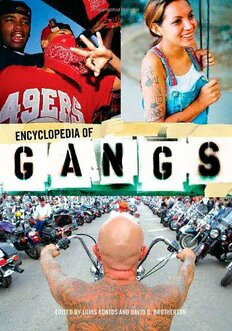
Encyclopedia of Gangs PDF
313 Pages·2008·2.762 MB·English
Most books are stored in the elastic cloud where traffic is expensive. For this reason, we have a limit on daily download.
Preview Encyclopedia of Gangs
Description:
In 1927 the first book on gang life, Frederic Thrasher’s The Gang: A Study of 1,313 Gangs in Chicago, was published. Only in the last 20 years, as gangs have spread from the inner cities to the suburbs and beyond, has the study of gangs become more than just a specialization in sociology and criminology. For this new encyclopedia, two editors and approximately 60 other contributors have written 82 signed entries exploring gangs and public policies and programs designed to deal in a positive manner with the problem of gangs. The alphabetical entries range from one-half page (Non-racist skinheads) to 12 pages (Mexican gangs). Words in bold type indicate a separate entry in the encyclopedia. A list of references and suggested readings at the end of each entry leads the reader to more in-depth works. The preface and introduction set the stage for the detailed overview of gangs that follows. An index completes the volume. The introduction highlights four areas that are covered in the encyclopedia: gang theory, gang practices, gang types, and gang expansion. Examples of entries on gang theory are Differential association theory and Subcultural theories of gangs. Gang practices include such topics as Gang clothing, Gang graffiti, and Gang symbols. Gang types include Gangs in U.S. schools and Gangs in prisons; ethnic gangs (e.g., The Black Hand and Jewish gangs and gangsters); and gender gangs (e.g., The Latin Queens). Gang expansion is covered in such entries as Australian youth gangs and Transnational gangs. A list of entries and a guide to related topics precede the alphabetical entries. This first encyclopedia on the subject of gangs definitely delivers what the editors intended: an orientation to the subject, a stimulation of curiosity, and guidance for further investigation of the subject by the reader. Recommended for academic and large public libraries. — Kaye Talley
See more
The list of books you might like
Most books are stored in the elastic cloud where traffic is expensive. For this reason, we have a limit on daily download.
